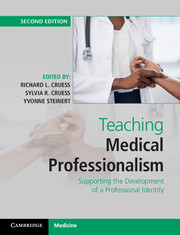Book contents
- Frontmatter
- Contents
- List of contributors
- Foreword
- Introduction
- Part I What is to be taught and learned
- Part II Theory
- Part III Principles
- 8 General principles for establishing programs to support professionalism and professional identity formation at the undergraduate and postgraduate levels
- 9 Faculty development to support professionalism and professional identity formation
- 10 Becoming interprofessional: professional identity formation in the health professions
- 11 Assessment of professionalism and progress in the development of a professional identity
- 12 Remediation of unprofessional behavior
- 13 Professional identity formation, the practicing physician, and continuing professional development
- 14 Professionalism, professional identity, and licensing and accrediting bodies
- Part IV Case studies in promoting professionalism and professional identity formation across the continuum
- Part V The future
- Index
- References
9 - Faculty development to support professionalism and professional identity formation
from Part III - Principles
Published online by Cambridge University Press: 05 April 2016
- Frontmatter
- Contents
- List of contributors
- Foreword
- Introduction
- Part I What is to be taught and learned
- Part II Theory
- Part III Principles
- 8 General principles for establishing programs to support professionalism and professional identity formation at the undergraduate and postgraduate levels
- 9 Faculty development to support professionalism and professional identity formation
- 10 Becoming interprofessional: professional identity formation in the health professions
- 11 Assessment of professionalism and progress in the development of a professional identity
- 12 Remediation of unprofessional behavior
- 13 Professional identity formation, the practicing physician, and continuing professional development
- 14 Professionalism, professional identity, and licensing and accrediting bodies
- Part IV Case studies in promoting professionalism and professional identity formation across the continuum
- Part V The future
- Index
- References
Summary
The greatest difficulty in life is to make knowledge effective, to convert it into practical wisdom.
Sir William Osler
The role of faculty development in promoting the teaching and learning of professionalism has grown substantially in the last decade, and several programs designed to enhance the knowledge, skills, and attitudes of clinical teachers and program directors in this area have been described.1,2 At the same time, while the importance of professional identity formation has been identified by a number of authors in the field,3,4 faculty development activities to support professional identity formation have, to date, not been described. Moreover, although there is a growing consensus regarding the importance of teaching and assessing professionalism,5–9 many faculty members are unable to articulate either the attributes and behaviors characteristic of the physician as a professional or how they can best facilitate the process of “becoming a physician.” Additionally, clinical teachers are frequently not sure how to teach this content area and support professional identity formation. As a result, faculty development is needed to ensure the successful teaching, learning, and assessment of professionalism as well as the formation of a professional identity, during both undergraduate and postgraduate training.
The goals of this chapter are to outline the principles and strategies underlying faculty development designed to facilitate the teaching and assessment of professionalism and the support of professional identity formation. In addition, we will highlight the role of faculty development in enhancing role modeling, promoting reflection, capitalizing on experiential and work-based learning, and supporting communities of practice. Several case examples, based on our own experiences, will also be provided.
Faculty development, or staff development as it is often called, refers to that broad range of activities that institutions use to renew or assist faculty in their multiple roles.10 Moreover, although faculty development has traditionally been defined as a planned program designed to prepare institutions and faculty members for their various roles,11 healthcare professionals engage in both formal and informal faculty development to enhance their knowledge and skills. In fact, much of their professional development is self-directed and linked to experiential and work-based learning. For the purpose of this discussion, faculty development will refer to all activities health professionals pursue to improve their knowledge, skills, and behaviors as teachers and educators, leaders and managers, and researchers and scholars, in both individual and group settings.
- Type
- Chapter
- Information
- Teaching Medical ProfessionalismSupporting the Development of a Professional Identity, pp. 124 - 139Publisher: Cambridge University PressPrint publication year: 2016
References
- 4
- Cited by

